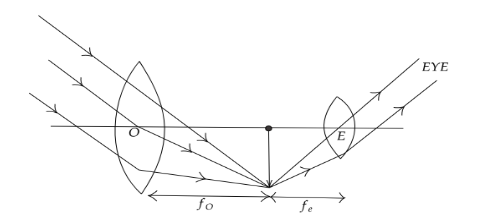
Answer
341.7k+ views
Hint: First draw a ray diagram of an astronomical telescope so as to analyze the problem briefly and it will be easy to use the sign conversion while calculating the solution. We know the angular magnification now applying this angular magnification formula we can find the relation between the focal length of the objective and eyepiece lens. Now putting this relation in the separation formula of the astronomical telescope we can find the respective values.
Complete step by step solution:
As per the problem we know there is an astronomical telescope that has an angular magnification of magnitude $ 5 $ for distant objects. The separation between the object and an eyepiece is $ 36cm $ and the final image is formed at infinity.
We need to calculate the focal length $ f_O $ of the objective and $ f_e $ of the eyepiece lens.

We have,
Angular magnification equals $ 5 $ .
We know the angular magnification of an astronomical telescope is represented as,
$ m = \dfrac{{f_O}}{{f_e}} $
Putting the given value we will get,
$ 5 = \dfrac{{f_O}}{{f_e}} $
Rearranging the above equation we will get,
$ 5f_e = f_O $
Now in the given problem,
The separation between the object and an eyepiece is $ 36cm $ and the final image is formed at infinity.
Hence,
$ L = f_O + f_e $
Where,
L is the separation.
Now putting the known vale we will get,
$ 36cm = 5f_e + f_e $
$ \Rightarrow 36cm = 6f_e \Rightarrow f_e = 6cm $
Now with relation between focal length of objective and eyepiece we will get,
$ 5f_e = f_O $
$ \Rightarrow 5 \times 6cm = f_O = 30cm $
Therefore the correction option is $ \left( D \right) $ .
Note:
Now here our eyepiece focal length is taken as negative as it lies on the left side of the eyepiece length. And by default we have taken the right side as positive. Remember that an astronomical telescope always forms virtual, inverted and magnified images and the focal length of this telescope is small.
Complete step by step solution:
As per the problem we know there is an astronomical telescope that has an angular magnification of magnitude $ 5 $ for distant objects. The separation between the object and an eyepiece is $ 36cm $ and the final image is formed at infinity.
We need to calculate the focal length $ f_O $ of the objective and $ f_e $ of the eyepiece lens.

We have,
Angular magnification equals $ 5 $ .
We know the angular magnification of an astronomical telescope is represented as,
$ m = \dfrac{{f_O}}{{f_e}} $
Putting the given value we will get,
$ 5 = \dfrac{{f_O}}{{f_e}} $
Rearranging the above equation we will get,
$ 5f_e = f_O $
Now in the given problem,
The separation between the object and an eyepiece is $ 36cm $ and the final image is formed at infinity.
Hence,
$ L = f_O + f_e $
Where,
L is the separation.
Now putting the known vale we will get,
$ 36cm = 5f_e + f_e $
$ \Rightarrow 36cm = 6f_e \Rightarrow f_e = 6cm $
Now with relation between focal length of objective and eyepiece we will get,
$ 5f_e = f_O $
$ \Rightarrow 5 \times 6cm = f_O = 30cm $
Therefore the correction option is $ \left( D \right) $ .
Note:
Now here our eyepiece focal length is taken as negative as it lies on the left side of the eyepiece length. And by default we have taken the right side as positive. Remember that an astronomical telescope always forms virtual, inverted and magnified images and the focal length of this telescope is small.
Recently Updated Pages
How many sigma and pi bonds are present in HCequiv class 11 chemistry CBSE

Mark and label the given geoinformation on the outline class 11 social science CBSE

When people say No pun intended what does that mea class 8 english CBSE

Name the states which share their boundary with Indias class 9 social science CBSE

Give an account of the Northern Plains of India class 9 social science CBSE

Change the following sentences into negative and interrogative class 10 english CBSE

Trending doubts
Onam is the main festival of which state A Karnataka class 7 social science CBSE

Fill the blanks with the suitable prepositions 1 The class 9 english CBSE

Which are the Top 10 Largest Countries of the World?

Difference between Prokaryotic cell and Eukaryotic class 11 biology CBSE

Differentiate between homogeneous and heterogeneous class 12 chemistry CBSE

The Equation xxx + 2 is Satisfied when x is Equal to Class 10 Maths

Who was the founder of muslim league A Mohmmad ali class 10 social science CBSE

Select the word that is correctly spelled a Twelveth class 10 english CBSE

Give 10 examples for herbs , shrubs , climbers , creepers



